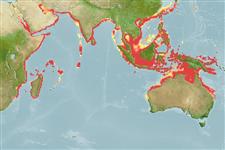Teleostei (teleosts) >
Eupercaria/misc (Various families in series Eupercaria) >
Lutjanidae (Snappers) > Lutjaninae
Etymology: Pinjalo: A Malay word, pinialo, for a fish.
More on author: Bleeker.
Environment: milieu / climate zone / depth range / distribution range
Ecology
Marine; reef-associated; depth range 15 - 100 m (Ref. 90102). Tropical; 31°N - 27°S, 32°E - 155°E (Ref. 55)
Indo-West Pacific: Persian Gulf to the Gulf of Papua (Papua New Guinea), north to Taiwan.
Size / Weight / Age
Maturity: Lm ? range ? - ? cm
Max length : 80.0 cm TL male/unsexed; (Ref. 47613); common length : 30.0 cm TL male/unsexed; (Ref. 55)
Adults inhabit reefs and rocky bottoms (Ref. 30573). They are found in schools over shallow depths of a few meters in open ocean reefs. In most areas they are found in deep waters and are usually trawled to 100 m depth (Ref. 48635). They feed on benthic and planktonic invertebrates (Ref. 30573), and possibly small fishes. Marketed fresh or dried-salted.
Life cycle and mating behavior
Maturity | Reproduction | Spawning | Eggs | Fecundity | Larvae
Randall, J.E., G.R. Allen and W.D. Anderson Jr., 1987. Revision of the Indo-Pacific lutjanid genus Pinjalo, with description of a new species. Indo-Pac. Fish. (14):17 p. (Ref. 6177)
IUCN Red List Status (Ref. 130435: Version 2024-2)
Threat to humans
Harmless
Human uses
Fisheries: minor commercial
Tools
Special reports
Download XML
Internet sources
Estimates based on models
Preferred temperature (Ref.
123201): 23.6 - 28.6, mean 27.6 °C (based on 770 cells).
Phylogenetic diversity index (Ref.
82804): PD
50 = 0.7500 [Uniqueness, from 0.5 = low to 2.0 = high].
Bayesian length-weight: a=0.01479 (0.00709 - 0.03087), b=2.96 (2.79 - 3.13), in cm total length, based on LWR estimates for this (Sub)family-body shape (Ref.
93245).
Trophic level (Ref.
69278): 4.0 ±0.48 se; based on food items.
Resilience (Ref.
120179): Low, minimum population doubling time 4.5 - 14 years (Preliminary K or Fecundity.).
Fishing Vulnerability (Ref.
59153): Moderate to high vulnerability (52 of 100).
Nutrients (Ref.
124155): Calcium = 25.7 [15.7, 43.3] mg/100g; Iron = 0.472 [0.261, 0.789] mg/100g; Protein = 18.9 [17.1, 20.6] %; Omega3 = 0.131 [0.089, 0.200] g/100g; Selenium = 44 [28, 74] μg/100g; VitaminA = 59 [21, 175] μg/100g; Zinc = 0.952 [0.701, 1.305] mg/100g (wet weight);
